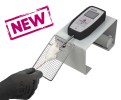Authors
Menzies FM, Garcia-Arencibia M, Imarisio S, o'sullivan NC, Ricketts T, Kent BA, Rao MV, Lam W, Green-Thompson ZW, Nixon RA, Saksida LM, Bussey TJ, o'kane CJ, Rubinsztein DC
Lab
Cambridge Institute for Medical Research, University of Cambridge School of Clinical Medicine, Cambridge, UK
Journal
Cell Death Differ.
Abstract
Over recent years, accumulated evidence suggests that autophagy induction is protective in animal models of a number of neurodegenerative diseases. Intense research in the field has elucidated different pathways through which autophagy can be upregulated and it is important to establish how modulation of these pathways impacts upon disease progression in vivo and therefore which, if any, may have further therapeutic relevance. In addition, it is important to understand how alterations in these target pathways may affect normal physiology when constitutively modulated over a long time period, as would be required for treatment of neurodegenerative diseases. Here we evaluate the potential protective effect of downregulation of calpains. We demonstrate, in Drosophila, that calpain knockdown protects against the aggregation and toxicity of proteins, like mutant huntingtin, in an autophagy-dependent fashion. Furthermore, we demonstrate that, overexpression of the calpain inhibitor, calpastatin, increases autophagosome levels and is protective in a mouse model of Huntington's disease, improving motor signs and delaying the onset of tremors. Importantly, long-term inhibition of calpains did not result in any overt deleterious phenotypes in mice. Thus, calpain inhibition, or activation of autophagy pathways downstream of calpains, may be suitable therapeutic targets for diseases like Huntington's disease.
BIOSEB Instruments Used:
Grip strength test (BIO-GS3)

 Pain - Thermal Allodynia / Hyperalgesia
Pain - Thermal Allodynia / Hyperalgesia Pain - Spontaneous Pain - Postural Deficit
Pain - Spontaneous Pain - Postural Deficit Pain - Mechanical Allodynia / Hyperalgesia
Pain - Mechanical Allodynia / Hyperalgesia Learning/Memory - Attention - Addiction
Learning/Memory - Attention - Addiction Physiology & Respiratory Research
Physiology & Respiratory Research
 Pain
Pain Central Nervous System (CNS)
Central Nervous System (CNS) Neurodegeneration
Neurodegeneration Sensory system
Sensory system Motor control
Motor control Mood Disorders
Mood Disorders Other disorders
Other disorders Muscular system
Muscular system Joints
Joints Metabolism
Metabolism Cross-disciplinary subjects
Cross-disciplinary subjects Preclinical studies and opioids: role in crisis management in the United States
Preclinical studies and opioids: role in crisis management in the United States 